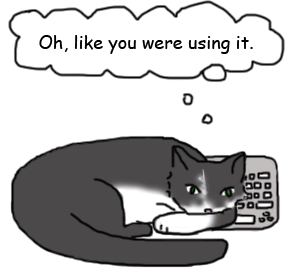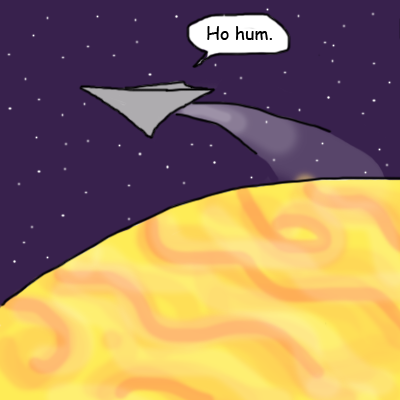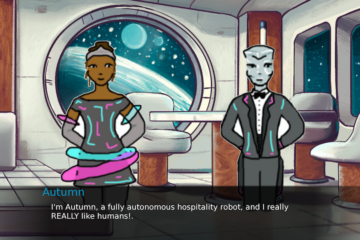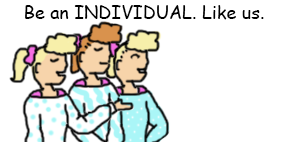I had three-quarters of five novels in my closet, and twenty or so halves of short stories in my desk drawer. Let’s not mention the stuff in my sewing room… my life was full of unread books, unfinished mending, and knitting projects that were just a bag of yarn and a printed pattern.
Then one day, 70 published short stories and uncounted garments later, a friend asked me, “Wow, how do you finish everything you start?”
I began to correct her, and realized … somehow, over the years, I had gone from a helpless pile of unfinished projects to a compulsive finisher.
This blog post is what I wish I could tell past-me to speed up that long journey.
First, you have to understand what stops finishing:
- Perfectionism
- Uncertainty
- Distraction
- Boredom
Perfectionism

Perfectionism is the source of most writer’s block. My friend Maureen McHugh says, “Writer’s block is not the inability to write. It is the belief that everything you write is shit.”
That staring at the blank page, that dread … no word you type will be as brilliant as the thought in your head, because thoughts are intangible, unobtainable. The reflected rose in a drop of dew that is better than all the roses around it in the garden, because you can’t touch it.
Mary Turzillo, my writing mom, told me when I was quite young that she had a sign taped over her computer that read, “It’s only a rough draft.”
You can revise. You will revise. No one has to see your “behind the scenes.” The sleeve you sewed in backward and had to take apart again. The first pot holder you knit that sorta came out egg-shaped.
It can be hard to remember, when we only see other people’s polished work, that every lovely work of art stands on a mountain of garbage drafts.
Don’t let perfect be the enemy of good enough! Creative work has no “right” way. As Bob Ross said, “There are no mistakes, only happy little accidents.”
The way I combat perfectionism is by letting myself write shitty first drafts. I let myself make bad clothes, bad knit garments, draw bad drawings. I tell myself, “This is the test project, it’s just for me.”
Here’s what one of my shitty first drafts looks like:
Ki created a distraction. Thane escaped and followed her. Amoreena was there too. They flew away to the lava caves for a chase scene with lava.
Here’s the second draft – still not the final (I’m not done writing this):
The smoke bomb detonated, causing her drone to wobble, but it was enough to distract the guard. Ki wrenched the door open and kicked it to keep it that way, using the momentum to drive herself fist-first into the guard.
Thane stared at her in disbelief. “Come on,” Ki grabbed him.
Could I have just written that second draft first? Technically, yes. I had the ability to write, to press keys or move a pen. But starting with the shitty draft made it feel like I was walking on a trod path, instead of pushing my legs through deep snow.
Uncertainty
The real hard work of creativity is decision making. Researchers have shown that decision-making burns calories. It’s real effort! Self-help books are full of advice to remove decision-making from your life so you can focus on the decisions that matter.
It can stop you cold to reach a decision in a project. “Crap this doesn’t fit, do I take out the seam allowance or put in a dart? I don’t have enough fabric, do I go slightly-matching or contrast?”
“How do my main characters escape this time? What emotion do I want to convey in this scene? Do I want them to escape at all?”
Decisions can drown you into analysis paralysis as you weigh options. Options sprout options, decisions sprout decisions. If the heroes escape, do the bad guys follow them?
The worst decision is not the wrong decision. It is no decision.
Try making the wrong decision. See where it takes you.
One time, I was trying to figure out how to make a dress longer (It had ended up way too short after hemming). “I could add a lace edge, but that’d be stupid,” I said. Then I added the lace edge with a basting stitch so it would be easy to undo, and that was … kinda perfect.
Or writing, I had a story and I wasn’t sure how to get the good guys out of the mess I’d put them in. “It would be stupid for them to steal a car,” I said. So … then I had them steal a car. I even had the character think, “Well, this is throwing gasoline on my problems.” It worked. Go ahead, do the thing that would never work. Maybe it will, or maybe it will show you more of the parameters you aren’t telling yourself about what you want to have happen. That happens much more often for me.
Working on the sequel to Galactic Hellcats, I needed the hellcats to abandon their space-motorcycles for plot reasons, to go into a restaurant and meet a new character. I didn’t know how to do it so I went with the Bugs Bunny option … they are being chased and they park behind a billboard. My first readers were all “No way they would leave the flyers!”
But I wouldn’t have written the rest of the chapter without that bad bit, and it was easy for me to go back and think, later, “OH! Why not have them hide their fliers in the parking lot for the restaurant instead?” which gave them a much more plausible reason to get out and stretch their legs!
If you find yourself unable to make the wrong decision, narrow down your options. List them, then cross off the one you like the least until one (or at least fewer) are left.
Who done it?
The Butlertoo cliché!The Maiddon’t want a working-class villainThe Eccentric AuntI like her too much- The Quiet Cousin
My main charactereek no- The nosy neighbor
On this list, I eliminated my main character first – I’m not feeling up to the difficulty of an unreliable narrator – then the butler, then the Eccentric Aunt, then the maid … now I only have two options! Hrm… I think no one would suspect the nosy neighbor! There, decision made.
Whatever it takes, make the decision. Throw a dart. Roll a die. You can always go back and un-make it if it doesn’t work.
The other thing I do, and I recommend this for smaller decisions, is skip them. This works better in writing than other crafts, though I have hand-sewn a handkerchief hem on an unfinished dress because I didn’t want to decide on using a zipper or buttons. If you can skip a step and continue making progress on a project, do it. The sunk cost of all that time will make the decision that much more urgent, and that might be what it takes to kick your brain into gear.
In writing, I use brackets to mark things that need to be decided on, then when I’m in a better mood to make decisions, I go back and replace them. Like this:
[name1] sagged in [name2]’s grip. “I … I am so sorry.”“Get the [important object] out of there, and let’s leave before—”
Her words were cut off by [scary thing].
Is your uncertainty caused by a secret rule?
We all have an annoying busybody living in the back of our heads who whispers things like “You can’t use two patterned fabrics together!” or “If you write a sex scene people will think you’re dirty” or “This must be more ambitious than last year’s fair entry!” – Cultural expectations, personal hang-ups, fears of being judged or found wanting.
I call them “secret rules” because often, we aren’t aware of them. Meditate a moment. Is there a constraint you are unnecessarily putting on your work? Give yourself permission to throw it off. Who is writing this story, anyway? You or that prissy busybody in your hippocampus?
Distraction

One of the most common laments I hear from my fellow creatives is, “I should finish all these projects I started, but I just got an idea for a much better project!”
I call this the “oo pretty” problem, and it’s a killer. What’s this boring old project with all its identified problems compared to a glossy new idea that hasn’t been born yet?
The first thing I tell people is, this is normal, this is okay. You are a human animal and we’re like this. Don’t fight it; use it.
Active procrastination is the process whereby you use your procrastination on one project to get work done on another. Or, I say “I’ll write the first scene of this Oo Pretty story, but then I have to work on Old Work In Progress before I write the second one.” Or, “I’ve written as far as I can on Oo Pretty. Now what? Oh, I can work on Old Work while I think about it.”
So I dangle the Oo Pretty as a motivator and a treat, and I use the Old Work and Oo Pretty together, to procrastinate on each other in turn.
Really, it’s not procrastination if you’re being productive! Embrace procrastination. It’s the only way I get anything done.
Another way to handle the distraction is through meditation techniques. A basic meditation consists of thinking actively about the moment you are in, and when intrusive thoughts inevitably enter (“Did I leave the oven on?” “Why did I say that stupid thing at dinner?”) you simply acknowledge them, and let them go.
Acknowledge the distraction. Say “I am being distracted” and let it go.
Another thing I do is remove the distractions. This can feel a little masochistic. I turn off my wifi. I go out to a park bench and write long-hand. Anything to make it harder for me to surf social media or research ancient button techniques when I should be working.

Some distractions can’t be avoided. “Real Life” distractions. You’re sick. Your kid is sick. Your dishwasher decides to give up the ghost and pees all over the kitchen floor, damaging the sub-floor, at the same time your roof is leaking … oh to state a Completely Random Example.
We JUST got that floor tiled.
AHEM. Again: this is okay, this is something that happens. I can’t always work on my projects. Sometimes the day job takes priority. Sometimes parenting takes priority. Sometimes the damn house imploding on itself takes priority. Unless you’re producing for a specific deadline, let the project go. Prepare to pick it up again.
That last sentence is the most important. Prepare to pick it up again. Be nice to future you. I make notes for myself, where I left off, what I had to do next, what the next decision is. Then I make a little google calendar reminder for, oh, a month in the future, to check my notes on projects to work on (and link where the notes are so I don’t have to look for them!)
Sometimes I reach that month in the future and I gotta make a new reminder two months in the future, but that’s okay. The point is to be the sort of person who can put something down and pick it up again, not to never put anything down. Whether you walk or take the bus, you get where you need to be eventually.
Boredom

Sometimes the project itself can feel no longer worth it. Not merely not as cool as Oo Pretty, but not as cool as doing the dishes or binge-watching a baking show.
One way to combat this is to reduce the friction it takes to work on the project. That resistance you feel when you sit down to work and just … don’t. You can reduce it either by laying out all the tools, or in the case of writing, leaving yourself clear guidance on what to write next. I have often heard other writers talk about leaving off in the middle of a sentence, even, so that initial moment sitting down, they have a guaranteed sequence of words to write.
(Advice from experience: Make sure it’s clear how that sentence ends? I came back once and was like “The heck, past me!?”)
But the most important thing you can do is re-discover the fun of the project.
Go back to the you who first thought of this idea. Be emotionally vulnerable and brutally honest with yourself. What excited you? Remember that feeling, that idea. Give yourself time to revel in it. Look at all the ways your project is already meeting that dream, and all the ways it isn’t. Take up arms (or needle, or pen) and fight for that initial idea, that germ of inspiration.
What a wonderful, perfect thing inspiration is. Reward it with your focus, your energy, and it will return again and again!
Finally, Finishing is a skill like any other. Practice it!
Setting a goal to write 1,000 words a day does nothing but make you good at writing a thousand words a day. And then beating yourself up because you only managed it five out of seven days. No. I set this goal every New Year’s Eve for five years and all it brought me was heartache.
My writing career took off when I made my goal “write a complete story a day” for a particular short period. The stories were garbage first drafts, but many of them became decent second drafts, and sale-able third drafts.
Good goals are Achievable, Timed, and Measurable. (ATM – it gets you money). I knew I could dash off a first draft with a beginning, middle, and end in one day, for a limited period of time when I was focusing on that. I also knew I wouldn’t be able to do it forever. This was a single, measured period of time. (It was six weeks, actually, for the Clarion Write-A-Thon). I defined a short story for this challenge as at least 1,000 words with a beginning and end.
I made that goal. And I haven’t looked back since.
Good luck. I hope I helped you become a Finisher in some way. Now, at least, I’ve finished my blog post.


